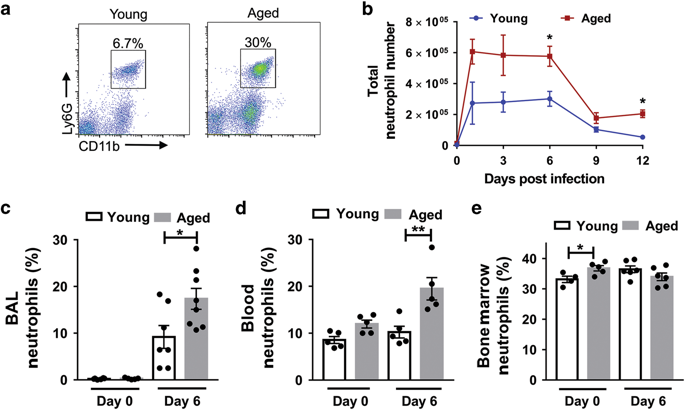Mucosal Immunology ( IF 8 ) Pub Date : 2019-01-07 , DOI: 10.1038/s41385-018-0115-3 Upasana Kulkarni 1 , Rachel L Zemans 1 , Candice A Smith 1 , Sherri C Wood 1 , Jane C Deng 1 , Daniel R Goldstein 1, 2, 3

|
Neutrophils clear viruses, but excessive neutrophil responses induce tissue injury and worsen disease. Aging increases mortality to influenza infection; however, whether this is due to impaired viral clearance or a pathological host immune response is unknown. Here we show that aged mice have higher levels of lung neutrophils than younger mice after influenza viral infection. Depleting neutrophils after, but not before, infection substantially improves the survival of aged mice without altering viral clearance. Aged alveolar epithelial cells (AECs) have a higher frequency of senescence and secrete higher levels of the neutrophil-attracting chemokines CXCL1 and CXCL2 during influenza infection. These chemokines are required for age-enhanced neutrophil chemotaxis in vitro. Our work suggests that aging increases mortality from influenza in part because senescent AECs secrete more chemokines, leading to excessive neutrophil recruitment. Therapies that mitigate this pathological immune response in the elderly might improve outcomes of influenza and other respiratory infections.
中文翻译:

肺部中性粒细胞水平过高是流感死亡率与年龄相关的增加的原因
中性粒细胞清除病毒,但过度的中性粒细胞反应会导致组织损伤并使疾病恶化。老龄化会增加流感感染的死亡率;然而,这是否是由于病毒清除受损或病理性宿主免疫反应所致尚不清楚。在这里,我们发现,流感病毒感染后,老年小鼠的肺中性粒细胞水平高于年轻小鼠。在感染后而非感染前消耗中性粒细胞可显着提高老年小鼠的存活率,而不会改变病毒清除率。流感感染期间,老化的肺泡上皮细胞 (AEC) 衰老频率较高,并分泌较高水平的中性粒细胞吸引趋化因子 CXCL1 和 CXCL2。这些趋化因子是年龄增强的中性粒细胞体外趋化作用所必需的。我们的研究表明,衰老会增加流感死亡率,部分原因是衰老的 AEC 会分泌更多趋化因子,导致中性粒细胞过度募集。减轻老年人这种病理性免疫反应的疗法可能会改善流感和其他呼吸道感染的结果。



























 京公网安备 11010802027423号
京公网安备 11010802027423号